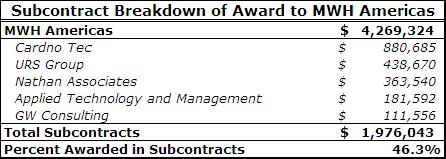February 12, 2013
On September 23, 2011 MWH Americas, previously alleged to have overcharged the city of New Orleans on reconstruction projects, was awarded a $2.8 million contract from the United States Agency for International Development (USAID) to conduct a “feasibility study of northern ports in Haiti.” The study is likely linked to the new, much touted Caracol Industrial Park in northern Haiti, which includes plans for new port facilities.
Within two weeks of receiving the $2.8 million contract, MWH Americas turned around and gave out $1.45 million in subcontracts to four different firms, all headquartered in Washington DC or Virginia. MWH gave $363,540 to Nathan Associates to perform “economic and financial studies on potential port projects,” including a review “of previous studies and existing conditions.” URS Group received $438,670; the project description for that subaward is simply “feasibility study of northern ports in Haiti,” the same as is listed for MWH. Meanwhile TEC Inc. (which later became Cardno-TEC Inc.) was awarded $620,123 to provide the “Senior Port Engineer,” “Senior Environmental Specialist” and the engineering and support staff to “perform” the feasibility study. Finally, GW Consulting Inc., was given $26,932 for security and logistics. At this point, there were five U.S. firms based in the DC area working on the feasibility study, each with its own staff and associated overhead costs. Firms are allowed to allocate a percentage of their contract to headquarters to cover general operating costs of the firm; this is known as the indirect cost rate. Although this information is not disclosed (and has been redacted in contracts obtained through the Freedom of Information Act), according to those familiar with the process it is generally around 20 percent.
Despite the millions already spent on the feasibility study, when the expected project completion date came, MWH was awarded $1 million to cover additional costs and the completion date was changed. Subsequently, MWH was awarded $435,000 in September 2012 and the completion date was pushed back to November 30, 2012. Since then, the completion date has been pushed back two more times and is now set for the end of February 2013. Of the additional $1.44 million awarded to MWH, they gave out some $550,000 in subcontracts. In total, as can be seen below, nearly 50 percent of the total award to MWH was spent on subcontracts to other U.S. firms.

The contract with MWH Americas is, however, commendable in one way. It is the only USAID contract in Haiti for which there is information on subcontractors, thanks to the fact that MWH actually reported their sub-awards to USASpending.gov. While MWH Americas is the only contractor to have done this, it is likely that many others are also required to do so. For example, Chemonics, the largest USAID contractor in Haiti (and the world) is required to report on their use of subcontractors, according to a copy of their contract acquired through a Freedom of Information Act request. Yet no information from any other contracts for work in Haiti appears on the USAspending.gov website. Additionally, there is legislation which now requires prime contractors to report sub-awards: the Federal Funding Accountability and Transparency Act, which was passed in 2006. Under the legislation, as of March 2011 all sub awards over $25,000 must be reported to a centralized system.
Direct inquiries to USAID for information on subcontracting have not been answered, while USAID’s primary contractors refer inquiries back to USAID. The USAID website previously stated that they do “not have the systems in place to track sub-grants and sub-contracts.” In late 2011, USAID was working on developing the systems to actually track this information in Haiti, however at least publicly, this has not yet happened.
The use of contractors to perform the feasibility study also is a result of the years of staff decline which led Hillary Clinton to declare that USAID is “more of a contracting agency than an operational agency with the ability to deliver.” The Government Accountability Office reported in November 2011 on the USAID ports project, noting that:
USAID’s program in Haiti has not previously involved port construction activities. With no staff who have port construction expertise or experience, USAID will rely on (1) a private firm to conduct a feasibility study and make recommendations regarding, among other things, port design, economic feasibility, and financial viability; and (2) a public private partnership to construct a new port.
And so, without the staff expertise, USAID turned to MWH Americas. In fact, the project was delayed before the contract to MWH was even signed. As the GAO noted, the contract was originally planned to be signed in June 2011. In September, when the contract was finally awarded, MWH was given 8 months and $2.8 million dollars to complete the task. Now, nearly 16 months later, the project is still not completed, and the total cost has increased by $1.5 million dollars, to $4.27 million. What the multiple contractors working with MWH have accomplished to date remains a mystery.






